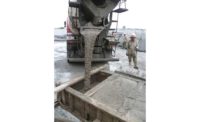"Has your company or its customers or users experienced any quality, workability, or durability challenges with lower embodied carbon construction materials and products? If so, please explain."
"What, if any, are the technical, economic or regulatory obstacles to reducing the embodied carbon of more of your materials or products?"
These and other questions related to "cleaner" construction are contained in a request for information from the U.S. General Services Administration, which is on a fact-finding mission to help establish federal agency procurement preferences for building materials and goods that contain less embodied carbon. GSA issued the RFI on Oct. 4 to help gather information about companies that offer materials or products for buildings that are "substantially—and demonstrably—lower in embodied carbon," compared to industry averages for similar materials or products.
The Federal Buy Clean Request for Information: Construction Materials with Substantially Lower Embodied Carbon focuses on the current availability of concrete, steel, asphalt, glass, aluminum, insulation, roofing materials, gypsum board and structural engineered wood that have substantially lower levels of embodied carbon. The RFI asks questions that run the gamut from which firms currently track greenhouse gas emissions caused by the manufacturing process to challenges developing environmental product declarations (EPDs) to whether production costs are higher for lower embodied-carbon products.
Fact Gathering Only
The RFI is for general fact gathering only. “Interested parties will not be reimbursed for any costs related to providing information,” says GSA, adding that there is no intention to award a contract on the basis of the response to the RFI.
In March, GSA issued new standards for concrete and asphalt used in nationwide GSA construction, modernization, and paving projects—the first standards in the U.S. to apply beyond a local jurisdiction, says GSA. To date, GSA has completed seven paving projects funded by the Infrastructure Investment and Jobs Act (IIJA) using the new asphalt standards, all of which were awarded to and completed by small or disadvantaged businesses without cost impact from the new standard.
“Today’s action follows our successful model of seeking industry input from concrete and asphalt manufacturers,” said GSA Administrator Robin Carnahan, in the Oct. 4 release about the current RFI.
Responses to the RFI are due by Nov. 3. Those firms that replied to GSA’s previous concrete and asphalt RFI, released Feb. 15, do not need to respond again.
“We will ask our members to respond to the current RFI,” says Lionel Lemay, the National Ready Mixed Concrete Association’s executive vice president for structures and sustainability. “Many of them already responded in February.”
The American Institute of Steel Construction plans to reply to the RFI. "We're encouraged that GSA is taking an open approach by engaging with industry for constructive input," says Max Puchtel, AISC's director of government relations and sustainability.
One concrete contractor already submitted its response, on Oct. 5, figuring that helping GSA—which manages a nationwide real estate portfolio of nearly 370 million sq ft of rentable space and oversees approximately $75 billion in annual contracts—will help everyone in the near and long term. "We know that lower embodied-carbon concrete is not just going to be nice to have, it’s going to be a requirement," says Jim Martinoski, a vice president of Miller & Long Co. Inc. "If we can help the GSA understand that concrete products are available now that have significant reductions in embodied carbon, we’re going to help them understand that as quickly and efficiently as possible."
The RFI follows President Biden’s Sept. 15 announcement of the Buy Clean Initiative to promote use of low-carbon construction materials, under the Federal Sustainability Plan and Executive Order 14057. Through Buy Clean, the federal government as a whole will, for the first time, prioritize the use of American-made, lower-carbon construction materials in federal procurement and federally funded projects.
Questions from GSA
Some more questions, paraphrased, from GSA's Oct. 4 RFI:
• If your company currently produces construction materials or products that are lower in embodied carbon, approximately what percentage of your construction material sales are currently for lower embodied carbon products?
• If your company tracks GHGs, has it developed a product-specific environmental product declaration for any construction materials or products? For the EPDs, what input data sources do you use, and are there gaps where specific necessary data is unavailable?
• If you do not have an EPD, how do you measure and document lower embodied carbon, compared to industry averages?
• Does your company participate in industry-wide greenhouse gas emissions benchmarking? If yes, through what organization? If not, are there certain barriers to developing industry-wide benchmarking capacity that you are aware of?
• How does the cost of your company's lower embodied carbon materials or products compare to that of conventional equivalents used to serve the same purpose?
• Is the strength and durability of your products tested using standard methods, such as standards developed through an American National Standards Institute process?
More broadly, GSA also is requesting that respondents share any implementation lessons learned or best practices associated with development, manufacturing, and marketing of lower carbon materials or products.





Post a comment to this article
Report Abusive Comment